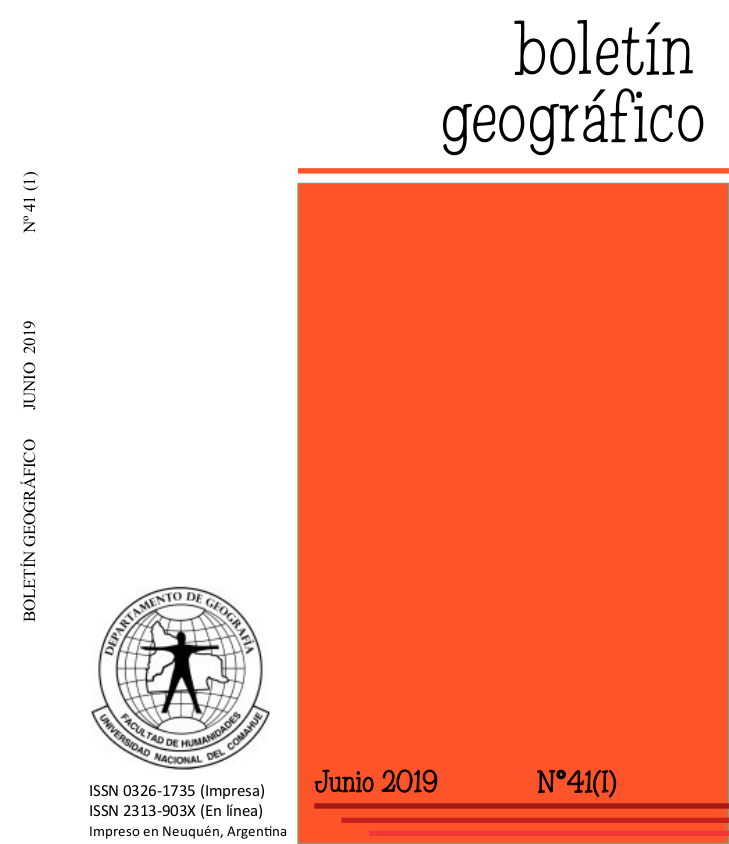Watershed delineation and codification in southern Patagonia
Keywords:
Hydrology, GIS, water resources, IWRMAbstract
Watershed definition is fundamental for integrated management of water resources, considering the social, productive and environmental demands. The watershed spatial delimitation is essential to understand eco-hydrological processes in the territory and management. The objective of this work was to delineate and code the hydrographic regions of Southern Patagonia under standardized procedures and new geographic information technologies. The ALOS World 3D model, WorldViewhigh-resolution scenes and QGIS 3.12 free software algorithms were used to carry out automated watershed delineations at various hydrological nesting levels, and subsequent coding and nomenclature. A precise cartographic product was achieved at a scale of1: 25,000 on a territory of 366,357.4 km2. This results in 7,307 hydrographic units distributed in 5 levels, with 14 large hydrographic regions (RH) in the upper level, 46 sub-regions, 249 hydrographic basins, 1,110 sub-basins and 5,888 micro-basins. The cartography achieved improved the resolution and precision of actual available regional products, representing a valuable tool for the sustainable water resources management at different levels of organization and complexity of natural processes.
Downloads
References
Alcaraz, S. A., Sannier, C., Vitorino, A. C. T. & Daniel, O. (2009). Comparison of methodologies for automatic generation of limits and drainage networks for hidrographic basins, Revista Brasileira de Engenharia Agrícola e Ambiental, 13 (4), 369-375. http://dx.doi.org/10.1590/S1415-43662009000400001
Barborak, J. R., Cuesta, F., Montes, C. & Palomo, I. (2015). Planificación en áreas protegidas: Territorio y cambio climático. Cooperación Alemana al Desarrollo GIZ, Ed. Visión. 61p.
Benedetti, J. C. (1999). Proceso de cálculo de la superficie continental de la República Argentina. Revista Cartográfica IPGH, 68, 73-79.
Berelson, W. L., Caffrey, P. A. & Hamerlinck, J. D. (2004). Mapping hydrologic units for the National Watershed Boundary Dataset. Journal of the American Water Resources Association, 40 (5), 1231-1246. https://doi.org/10.1111/j.1752-1688.2004.tb01582.x
Biblioteca del Congreso Nacional. (2017). Sistema Integrado de Información Territorial. Portal BCN. Accesada el día 15 de Abril de 2020. https://www.bcn.cl/siit
Borrini Feyerabend, G., Farvar, M. T., Solis, V. & Govan, H. (2001). Manejo conjunto de los recursos naturales: Organizarse, negociar y aprender en la acción. GTZ – UICN, Kasparek Verlag Ed, Heidelberg, Germany. 113 p.
Brooks, K. N., Ffolliott, P. F. & Magner, J. A. (2012). Hydrology and the management of watersheds. John Wiley & Sons Inc. (4th Ed.), USA. 545 p.
Bugayevskiy, L. M. & Snyder, J. P. (1995). Map Projections: A Reference Manual. Taylor &
Francis, London, 328 p.
Caglar, B., Becek, K., Mekik, C. & Ozendi, C. (2018). On the vertical accuracy of the ALOS World 3D-30m digital elevation model. Remote Sensing Letters, 9 (6), 607-615. https://doi.org/10.1080/2150704X.2018.1453174
CFI (1961). Recursos Hídricos Superficiales. Consejo Federal de Inversiones, Serie Evaluación de los recursos naturales de la Argentina, Tomo IV, Volumen I. Buenos Aires, 459 p.
CIREN (2014). Redefinición de la clasificación de la red hidrográfica a nivel nacional. Informe Final SDT 356, Dirección General de Aguas, República de Chile. https://snia.mop.gob.cl/sad/Informe_Final_de_la_Redefinicion_de_las_Cuencas_DGA.pdf
De Jager, A. L. & Vogt, J. B. (2010). Development and demonstration of a structured hydrological feature coding system for Europe. Hydrological Sciences Journal, 55 (5), 661-675. https://doi.org/10.1080/02626667.2010.490786
Diaz, B. G. & Giménez, M. (15 al 19 de junio de 2015). Zonificación y codificación hidrográfica en Santa Cruz (Patagonia Austral, Argentina). XXV Congreso Nacional del Agua, Paraná, Entre Ríos. Actas, 13 p.
Diaz, B. G. & Minatti, S. (19 al 21 de abril de 2006). Aplicación de información topográfica SRTM3 en la delimitación de grandes cuencas hidrográficas de la provincia de Santa Cruz. VI Jornadas Nacionales de Geografía Física, Río Gallegos, Santa Cruz, Actas 11 p.
DIFROL (2020). Mapas. Dirección Nacional de Fronteras y Límites del Estado, Ministerio de Relaciones Exteriores de Chile. Accesada el día 15 de Abril de 2020. https://difrol.gob.cl/
Dirección General de Aguas. (2014). Inventario de cuencas, subcuencas y subsubcuencas de Chile. Informe Técnico SDT 463, División de Estudios y Planificación, DGA, Chile. 54p. https://snia.mop.gob.cl/sad/CUH5690.pdf
Dirección General de Aguas. (2016). Atlas del Agua: Chile 2016. Ministerio de Obras Públicas, Chile. 24 p. http://bibliotecadigital.ciren.cl/handle/123456789/26705
Dourojeanni, A., Jouravlev, A. & Chávez, G. (2002). Gestión del agua a nivel de cuencas: teoría y práctica. CEPAL Serie Recursos Naturales e Infraestructura 47, Chile. 83 p. https://repositorio.cepal.org/handle/11362/6407
Dubreuil, P. L. (1986). Review of relationships between geophysical factors and hydrological characterisctics in the tropics. Journal of Hydrology, 87 (3-4), 201-222. https://doi.org/10.1016/0022-1694(86)90014-4
Ehlschlaeger, C. R. (1989). Using the AT Search Algorithm to develop hydrologic models from digital elevation data. Proceeding of the International Geographic Information System (IGIS) Symposium, Baltimore, USA, 275-281.
EORC & JAXA (2020). ALOS global digital surface model (DSM). Product description v3.1. https://www.eorc.jaxa.jp/ALOS/en/aw3d30/aw3d30v31_product_e_a.pdf
FAO (2006). The new generation of watershed management programmes and projects. FAO Forestry Paper 150, Rome, Italy. 137 p. http://www.fao.org/3/a0644e/a0644e00.htm
FAO (2017). Water for sustainable food and agriculture. A report produced for the G20 Presidency of Germany. FAO, Rome, Italy. 33 p. http://www.fao.org/3/a-i7959e.pdf
Farr, T. G., Rosen, P. A., Caro, E., Crippen R., Duren, R., Hensley, S., … & Umland, J. (2007). The Shuttle Radar Topography Mission. Reviews of Geophysics, 45 (2), 1-33. https://doi.org/10.1029/2005RG000183
Florinsky, I. V., Skrypitsyna, T. N. & Luschikova, O. S. (2018). Comparative accuracy of the AW3D30 DSM, ASTER GDEM and SRTM1 DEM: A case of study on the Zaoksky testing ground, Central European Russia. Remote Sensing Letters, 9 (7), 706-714. https://doi.org/10.1080/2150704X.2018.1468098
Giraut, M., Valladares, A. I.. Rey, C. A., Diaz, B. G. & Dente, M. V. (25 al 27 de junio de 2008). Mapa de cuencas y regiones hídricas superficiales de la provincia de Santa Cruz. IVº Congreso de la Ciencia Cartográfica, Buenos Aires. Actas. 11 p.
González, L. y Rial, P. (Ed.). (2004). Guía geográfica interactiva de Santa Cruz. INTA Ediciones, Argentina. 60 p.
Gupta, S. K. (2011). Modern Hydrology and sustainable water development. John Wiley & Sons Ltd. (Ed.), India. 464 p.
Hossain, M. Z. (2015). Water: The most precious resource of our life. Global Journal of Advanced Research, 2 (9), 1436-1445. http://gjar.org/articles/WATER--THE-MOST-PRECIOUS-RESOURCE-OF-OUR-LIFE
IGM (1946). Reglamento cartográfico. Instituto Geográfico Militar, República Argentina, 2da. Edición. https://www.ign.gob.ar/descargas/biblioteca/ReglamentoCarto1946.pdf
IGN (2019a). Modelo digital de elevaciones de la República Argentina versión 2.0. Instituto Geográfico Nacional, República Argentina. https://www.ign.gob.ar/archivos/Informe_MDE-Ar_v2.0_30m.pdf
IGN (2019b). Capas SIG. Instituto Geográfico Nacional, República Argentina. https://www.ign.gob.ar/NuestrasActividades/InformacionGeoespacial/CapasSIG.
INCYTH (1982). Delimitación de cuencas y regiones hídricas superficiales de la República Argentina: provincias de Santa Cruz y Chubut, E.1:1.000.000.
Jain, A. O., Thaker, T., Chaurasia, A., Patel, P. & Singh, A. K. (2017). Vertical accuracy evaluation of SRTM DEM GL1, GDEM v2, AW3D30 and CartoDEM v3.1 of 30 m resolution with dual frequency GNSS for Lower Tapi Basin India. Geocarto Internacional, 33 (11), 1237-1256. https://doi.org/10.1080/10106049.2017.1343392
Japan Aerospace Exploration Agency (2018). ALOS Global Digital Surface Model, ALOS World 3D – 30m. JAXA Earth Observation Research Center. Accesada el día 15 de Abril de 2020. https://www.eorc.jaxa.jp/ALOS/en/aw3d30/data/index.htm
Jenny, B. (2012). Adaptative composite map projections. IEEE Transactions on Visualization and Computer Graphics, 18 (12), 2575-2582. https://doi.org/10.1109/tvcg.2012.192
Khalifa, M. & Bidaisee, S. (2018). The importance of clean water. Journal of Scientific & Technical Research, 8 (5), 6780-6783. http://dx.doi.org/10.26717/BJSTR.2018.08.001719
Lai, Z., Li, S., Lv, G., Pan, Z. & Fei, G. (2016). Watershed delineation using hydrographic features and a DEM in plain river network region. Hydrological Processes, 30 (2), 276-288. https://doi.org/10.1002/hyp.10612
Lindsay, J. B., Rothwell, J. J. & Davies, H. (2008). Mapping outlet points for watershed delineation onto DEM-derived stream networks. Water Resources Research, 44 (8), W08442, 1-9. https://doi.org/10.1029/2007WR006507
MapTiler Team (2019). ESRI:102033 South American Albers Equal Area Conic. Coordinate systems worldwide. Accesada el día 15 de Abril de 2020. https://epsg.io/102033
Microsoft (2020). Bing Maps v8. Microsoft Open Source Map Projects. Accesado entre el 15 de abril y el 30 de agosto de 2020. https://docs.microsoft.com/en-us/bingmaps/
OpenLayers (2020). A high-performance, feature-packed library for all your mapping needs. Accesado entre el 15 de abril y el 30 de agosto de 2020. https://openlayers.org/
OSGeo (2019). GRASS Gis. GRASS Development Team. Accesado entre el 15 de abril y el 30 de agosto de 2020. https://grass.osgeo.org/grass7/
OSGeo (2020). QGIS, Sistema de Información Geográfica Libre y de Código Abierto. Accesado el 15 de abril de 2020. https://www.qgis.org/es
Pilgrim, D. H. (1983). Some problems in transferring hydrological relationships between small and large drainage basins and between regions. Journal of Hydrology, 65 (1-3), 49-72. https://doi.org/10.1016/0022-1694(83)90210-X
Pilgrim, D.H., Cordery, I. & Baron, B. C. (1982). Effects of catchment size on runoff relationships. Journal of Hydrology, 58 (3-4), 205-221. https://doi.org/10.1016/0022-1694(82)90035-X
Rexer, M. & Hirt, C. (2014). Comparison of free high resolution digital elevation data sets (ASTER GDEM2, SRTM v2.1/4.1) and validation against accurate heights from the Australian National Gravity Database. Australian Journal of Earth Sciences, 61 (2), 213-226. https://doi.org/10.1080/08120099.2014.884983
Santillán, J. R., Santillán, M. M. & Makinano, R. M. (2016). Vertical accuracy assessment of ALOS World 3D – 30 m digital elevation model over Northeastern Mindanao, Philippines. IEEE International Geoscience and Remote Sensing Symposium (IGARSS), 5374-5377. https://doi.org/10.1109/IGARSS.2016.7730400
Šavrič, B. & Jenny, B. (2016). Automating the selection of standard parallels for conic map projections. Computers & Geosciences, 90, 202-212. https://doi.org/10.1016/j.cageo.2016.02.020
Seaber, P. R., Kapinos, F. P. & Knapp, G. L. (1987). Hydrologic unit maps. USGS Water Supply Paper 2294. https://doi.org/10.3133/wsp2294
Snyder, J. P. (1987). Map projections – A working manual. USGS Professional Paper 1395. https://doi.org/10.3133/pp1395
SRNyDS (1998). Cartografía Hídrica Superficial de la República Argentina, Provincia de Santa Cruz. Dirección Nacional de Política Hídrica. Escala 1:3.508.772.
SAyDS (2019). Atlas de glaciares de la Argentina. Secretaría de Ambiente y Desarrollo Sustentable de la Nación. Buenos Aires, Argentina. 224 p.
SSRH (2010). Atlas de cuencas y regiones hídricas superficiales de la República Argentina. Subsecretaría de Recursos Hídricos, Ministerio de Planificación Federal – Instituto Nacional del Agua. Buenos Aires, Argentina. Escala 1:250.000.
SSRH (2002). Atlas Digital de los Recursos Hídricos Superficiales de la República Argentina. Subsecretaría de Recursos Hídricos de la Nación – Instituto Nacional del Agua. Buenos Aires, Argentina. Escala 1:500.000.
Tadono, T., Nagai, H., Ishida, H., Oda, F., Naito, S., Minakawa, K. & Iwamoto, H. (2016). Generation of the 30 m-Mesh Global Digital Surface Model by ALOS PRISM. International Archives of the Photogrammetry, Remote Sensing and Spatial Information Sciences, 41, 157-162. https://doi.org/10.5194/isprs-archivesXLI-B4-157-2016.
USGS (2013). Federal standards and procedures for the National Watershed Boundary Dataset (WBD). Techniques and Methods 11-A3, 4th Ed. USA. https://doi.org/10.3133/tm11A34
Verdin, K. L. & Verdin J. P. (1999). A topological system for delineation and codification of the Earth´s river basins. Journal of Hydrology, 218 (1-2), 1–12. https://doi.org/10.1016/S0022-1694(99)00011-6
Ziadat, F., Bunning, S. & De Pauw, E. (2017). Land resource planning for sustainable land management. FAO Working Paper 14. http://www.fao.org/publications/card/en/c/a36df3f9-62ee-46cd-86bc-d9c133a57bc8/
Zonneveld, I. S. (1989). The land unit – A fundamental concept in landscape ecology and its applications. Landscape Ecology, 3, 67-86. https://doi.org/10.1007/BF00131171
Additional Files
Published
How to Cite
Issue
Section
License
Copyright (c) 2021 Boletin GeográficoTransfer of rights and data processing
The acceptance of an article for publication in the Journal Geographic Bulletin implies the cession of the rights of printing and reproduction, by any means and means, of the author in favor of the Department of Geography of the National University of Comahue, which will not reject any request reasonable for the authors to obtain permission to reproduce their contributions. The total or partial reproduction of the works published in the Geographic Bulletin must be done citing the origin, otherwise, the copyright is violated.
Likewise, it is understood that the concepts and opinions expressed in each work are the sole responsibility of the author, without being responsible or in solidarity, necessarily, neither the editorial staff nor the editorial staff.
It is the responsibility of the authors to be able to provide interested readers with copies of the raw data, procedure manuals, scores and, in general, relevant experimental material.
Likewise, the Management of the journal guarantees the appropriate treatment of personal data
COPYRIGHT TRANSFER FORM


















 Journal of the
Journal of the 